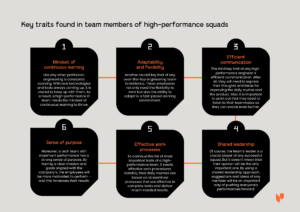Welcome to our enriched glossary! It spans the realms of business, career, and tech, designed to demystify jargon, including key insights from our clusters on Team Dynamics, Employment Structures, HR Expertise, and more.
Empower yourself with a deeper understanding of software team performance, HR metrics, and employee lifecycle stages.
We’ve crafted this resource to aid tech enthusiasts, HR professionals, and curious minds alike, ensuring clarity in the ever-evolving landscapes of business and technology.
[ez-toc]Team Dynamics
Team dynamics encapsulate the interplay of diverse skills, backgrounds, and roles within a collaborative environment. Understanding and optimizing these dynamics are pivotal for driving innovation, efficiency, and cohesion within software development teams.
Collocated Teams
Meaning: Teams working together in the same physical location or office.
Importance/Application: Collocated teams often experience improved communication and collaboration, enhancing software team performance and fostering cohesive workflows.
Hybrid Teams
Meaning: Hybrid Teams are those comprising both remote and on-site members. Some companies choose to have in-office and work-from-home days.
Importance/Application: Hybrid teams leverage the advantages of remote work while maintaining some physical presence, balancing flexibility and collaboration for effective software team performance.
Remote Teams
Meaning: Remote Teams are those collaborating and working together from different physical locations. Members work independently.
Importance/Application: Facilitates access to specialized talent worldwide, supporting software companies aiming to hire software engineers in Latin America and utilize nearshore software engineers for effective staff augmentation.
Distributed Teams
Meaning: Distributed Teams are those in which members work remotely from various locations. Members work fully integrated.
Importance/Application: Enables access to a diverse talent pool, fostering collaboration among professionals from different geographical areas, which aligns with maximizing software team performance and collaboration.
Digital Nomadism
Meaning: Digital Nomadism is a lifestyle enabling individuals to work remotely while traveling.
Importance/Application: Embracing digital nomadism can attract diverse talent and facilitate global team collaboration, supporting software companies in adopting flexible work arrangements and accessing specialized skill sets worldwide.
Work from Home (WFH)
Meaning: Work From Home refers to conducting work activities from one’s residence instead of a designated office space.
Importance/Application: Work-from-home arrangements enhance flexibility and work-life balance, contributing to employee satisfaction and, when managed effectively, can positively impact software team collaboration and performance.
Home Office
Meaning: A designated workspace within one’s home for professional activities.
Importance/Application: Establishing a home office promotes a conducive work environment, aiding in focus and productivity for remote workers, and ultimately supporting software team collaboration and performance.
Onshore Software Development
Meaning: Software development executed within the same country as the parent company or client.
Importance/Application: Onshore software development ensures closer collaboration and cultural alignment, beneficial for maintaining strong software team collaboration and performance.
Nearshore Software Development
Meaning: Software development conducted in nearby countries or regions.
Importance/Application: Nearshore development allows for geographical proximity, promoting better time zone alignment and cultural understanding, facilitating effective staff augmentation and software team collaboration.
Nearshore Software Engineers
Meaning: Software engineers located in nearby countries or regions.
Importance/Application: Leveraging nearshore talent allows for efficient collaboration within compatible time zones, enhancing software team performance and facilitating distributed team dynamics.
Hire Software Engineers in Latin America
Meaning: The act of recruiting software engineers specifically from Latin American countries.
Importance/Application: Hiring talent from Latin America offers proximity, cultural alignment, and expertise, making it ideal for staff augmentation and reinforcing team collaboration.
Offshore Software Development
Meaning: Software development conducted in a different country, often far from the parent company or client.
Importance/Application: Offshore development provides cost-effective solutions but can present challenges in communication and collaboration, impacting software team performance and collaboration strategies.

Regardless if your team members chose to rent coworking space or work from home, focus time is important. As productivity has it, isolation from distractions and noise is necessary. Add security concerns to the mix: it becomes obvious software professionals cannot work from public places. Photo by Sanni Sahil.
Employment and Organizational Structure
An effective employment structure is the backbone of any successful organization, delineating the relationships, roles, and responsibilities that govern operations. Establishing a robust organizational structure ensures clarity, efficiency, and adaptability in achieving strategic goals.
Navigate through this guide featuring a section meticulously designed to demystify intricate concepts through a clear business jargon explained segment, facilitating better understanding for professionals across industries.
Co-employment
Meaning: An agreement where multiple entities share legal responsibilities and liabilities concerning employees.
Importance/Application: Co-employment affects the organizational structure and management of workforce resources in collaborative endeavors.
Staff Augmentation
Meaning: Staff Augmentation is the temporary hiring of external resources to supplement an existing team for a specific project or duration.
Importance/Application: It allows companies to quickly access specialized skills and scale their teams without long-term commitments, ideal for short-term projects or skill-specific needs.
Project-Based Engagement
Meaning: Hiring external resources or teams to complete a defined project or deliverable.
Importance/Application: Project-based engagement allows companies to outsource entire projects, ensuring focused delivery without the need for permanent employment.
Managed Services
Meaning: Outsourcing specific business functions or processes to an external provider.
Importance/Application: Managed services enable companies to delegate entire processes, such as IT support or software maintenance, to specialized providers, allowing focus on core business activities.
Dedicated Development Team (DDT)
Meaning: Establishment of a remote team dedicated exclusively to the client’s project.
Importance/Application: DDT models provide extended and consistent support for long-term projects, ensuring continuity and expertise within a specific domain.
Build-Operate-Transfer (BOT)
Meaning: Partnering with an external entity to build and operate a project or service before transferring it back to the company.
Importance/Application: BOT models facilitate the setup and management of operations in different locations, often used when establishing subsidiaries or branches in foreign countries.
Outcome-Based Engagement
Meaning: Engaging resources based on the deliverables or outcomes achieved rather than the time spent.
Importance/Application: This model focuses on performance and results, aligning incentives with the successful achievement of predetermined goals or milestones.
Full-time Employees (FTEs)
Meaning: Individuals employed by a company on a permanent basis, typically working regular hours and receiving benefits.
Importance/Application: Full-time employees form the core workforce, providing stability, commitment, and continuity in software development teams, contributing to long-term project success.
Independent Contributors
Meaning: Individuals who work autonomously, contributing their expertise to projects without being formally employed by the client.
Importance/Application: Independent contributors offer specialized skills on a project basis, bringing external insights and flexibility to supplement existing teams.
Independent Contractors
Meaning: Self-employed professionals engaged on a contractual basis to deliver specific services or projects.
Importance/Application: Independent contractors provide expertise for specialized tasks or short-term projects, offering flexibility without long-term employment commitments.
Freelancers
Meaning: Self-employed individuals who work on multiple projects for different clients on a temporary or project-specific basis.
Importance/Application: Freelancers offer diverse skills and flexibility, ideal for short-term or specialized tasks within software development projects.
Full-time Work
Meaning: Employment requiring close to 40 hours per week.
Importance/Application: Offering full-time positions can attract dedicated professionals crucial for maintaining software team collaboration and ensuring consistent software team performance.
Part-time Work
Meaning: Employment involving fewer hours than a standard full-time job.
Importance/Application: Part-time roles can be beneficial for specific project needs, allowing flexibility while contributing to software team collaboration and performance.
Temporary Work
Meaning: Employment for a limited duration, often for a specific project or to cover short-term needs.
Importance/Application: Temporary work allows companies to address immediate needs or project-based demands, providing agility and access to specialized skills without long-term commitments.
Work Flexibility
Meaning: Arrangements allowing employees to manage professional and personal responsibilities effectively.
Importance/Application: Key in maintaining work-life balance, impacting employee retention and overall team dynamics.
Blended Workforce
Meaning: A workforce composed of full-time, part-time, temporary employees, and third-party contractors, fostering diverse collaboration within software teams.
Importance/Application: A blended workforce encourages varied perspectives and expertise, enhancing software team collaboration and adaptability to different project demands.

Successful talent management means focusing on both FTEs and non-FTE contributors. Photo by Carolina Arruda.
Software Team Performance Methodologies
Software team performance methodologies encompass systematic approaches and frameworks employed to enhance productivity, quality, and efficiency in software development. These methodologies shape how teams operate, collaborate, and deliver results effectively.
Software Team Performance
Meaning: The productivity, efficiency, and effectiveness of a software development team.
Importance/Application: Enhancing team performance is crucial for delivering high-quality software, a critical aspect when leveraging staff augmentation in LatAm to boost team capabilities.
Agile Methodology
Meaning: A project management approach emphasizing iterative development, collaboration, and flexibility in responding to change.
Importance/Application: Agile methodologies promote adaptability, transparency, and efficient delivery within software development teams.
Scrum
Meaning: An Agile framework facilitating teamwork, accountability, and iterative progress in software development projects.
Importance/Application: Scrum enables structured project management, emphasizing collaboration, frequent inspection, and adaptation.
Kanban
Meaning: A visual system for managing work in progress, promoting continuous delivery and optimizing workflow efficiency.
Importance/Application: Kanban aids in visualizing work, identifying bottlenecks, and ensuring a steady flow of tasks in software teams.
Sprint
Meaning: A time-boxed iteration in Agile development where a set of work is completed and ready for review.
Importance/Application: Sprints enforce focus, facilitate quick feedback, and drive incremental progress towards project goals.
Velocity
Meaning: A measure of a team’s capacity to deliver work in a sprint, often measured in story points or tasks completed.
Importance/Application: Velocity helps in forecasting and planning future sprints, enabling teams to set realistic goals and optimize their workflow.

Talent development enhances employees’ skills, knowledge, and abilities to improve performance and achieve organizational goals. Photo by Nik.
Software Team Performance Metrics
Performance metrics offer quantifiable measures that gauge the effectiveness, output, and impact of software teams. Tracking and analyzing these metrics facilitate informed decision-making, process optimization, and continuous improvement.
Uncover the specialized section in our guide, dedicated to simplifying complex jargon and technicalities with a concise tech keyword guide, enabling easier comprehension of intricate tech-related concepts.
Burndown Chart
Meaning: Graphical representation of work completed against the work planned for a sprint or project phase.
Importance/Application: Burndown charts track progress, visualize trends, and help teams identify deviations from the planned trajectory.
Lead Time
Meaning: The time taken from the initiation of a task or feature to its completion.
Importance/Application: Lead time measures efficiency and workflow effectiveness, highlighting areas for optimization in software development cycles.
Cycle Time
Meaning: The time taken to complete a single task or unit of work from start to finish.
Importance/Application: Cycle time assesses the speed of delivery, helping teams identify and reduce bottlenecks in their processes.
Defect Density
Meaning: Number of defects identified per lines of code or function points.
Importance/Application: Defect density indicates software quality and helps in allocating resources for debugging and improvement.
Code Churn
Meaning: Rate of code changes or churn, often measured by the frequency of code commits or alterations.
Importance/Application: Code churn measures code stability and helps in evaluating the impact of changes on software development.
Customer Satisfaction
Meaning: Feedback or satisfaction scores gathered from end-users or stakeholders.
Importance/Application: Customer satisfaction metrics reflect the success of delivered software in meeting user needs and expectations.

Key traits in members of high-performance squads
Software Team Collaboration Practices
Collaboration practices delineate the methods and frameworks employed to foster seamless interaction, knowledge sharing, and synergy among software teams. Effective collaboration practices amplify creativity, problem-solving, and project outcomes.
Software Team Collaboration
Meaning: The act of individuals working together on software projects.
Importance/Application: Effective collaboration is pivotal for distributed and remote teams, ensuring streamlined communication and cohesive efforts, particularly when augmenting staff in Latin America.
Change Management
Meaning: The strategic approach to managing transitions within an organization.
Importance/Application: Enables smooth adaptation to changes, maintaining software team performance amid evolving circumstances.
Stand-up Meeting
Meaning: Brief daily meetings where team members discuss progress, challenges, and plans for the day.
Importance/Application: Stand-up meetings foster communication, alignment, and problem-solving, enhancing team coordination and efficiency.
Collaboration Tools
Meaning: Software platforms or applications facilitating communication, sharing, and coordination among team members.
Importance/Application: Collaboration tools streamline communication, document sharing, and project management, fostering seamless teamwork.
Version Control
Meaning: Systematic management of changes to documents, code, or files, allowing tracking and coordination of revisions.
Importance/Application: Version control ensures consistency, tracks modifications, and prevents conflicts in collaborative software development.
Remote Collaboration
Meaning: Collaborative work conducted by team members located in different geographic locations or working remotely.
Importance/Application: Remote collaboration tools enable effective teamwork, allowing dispersed teams to communicate and work together efficiently.
Mentoring
Meaning: A practice involving experienced employees guiding and supporting less experienced team members.
Importance/Application: Fosters knowledge sharing and skill development, enhancing collaboration and overall team performance.
Pair Programming
Meaning: Agile software development technique where two programmers work together on one workstation.
Importance/Application: Pair programming enhances code quality, knowledge sharing, and problem-solving within software development teams.
Code Review
Meaning: Systematic examination of source code by team members to identify errors, ensure quality, and share knowledge.
Importance/Application: Code reviews improve software quality, foster learning, and maintain coding standards within development teams.
Agile Ceremonies
Meaning: Structured meetings or events in Agile methodologies (e.g., Sprint Planning, Retrospectives, Daily Stand-ups).
Importance/Application: Agile ceremonies facilitate collaboration, alignment, and continuous improvement within software development teams.
Brainstorming
Meaning: Group discussion or session aimed at generating new ideas, solutions, or approaches.
Importance/Application: Brainstorming fosters creativity, encourages diverse perspectives, and generates innovative solutions in software development.
Cross-Functional Teams
Meaning: Teams comprising members with diverse skills and expertise collaborating on a project.
Importance/Application: Cross-functional teams leverage diverse talents, leading to holistic problem-solving and comprehensive project outcomes.
Knowledge Sharing
Meaning: Process of disseminating information, expertise, or best practices among team members.
Importance/Application: Knowledge sharing enhances collaboration, accelerates learning, and improves overall team performance.
Virtual Whiteboards
Meaning: Online or digital platforms simulating physical whiteboards for visualizing ideas, plans, or concepts.
Importance/Application: Virtual whiteboards aid remote collaboration, allowing teams to ideate, organize, and collaborate on visual content.

The Role of Leadership in Leading Remote Teams involves understanding the nuances of Distributed Team Management and creating strategies that ensure effective collaboration and trust. Photo by Lala Azizli.
Human Resources (HR) Expertise
Human Resources expertise embodies the strategic management of an organization’s most valuable asset—its people. It encompasses recruitment, training, employee relations, and compliance, crucial for creating a conducive work environment.
Within our comprehensive guide, we’ve curated an extensive HR glossary covering fundamental terms and concepts relevant to human resources, aiding in a deeper understanding of this domain’s terminology.
Talent Acquisition
Meaning: The process of identifying, attracting, and hiring suitable candidates for job positions.
Importance/Application: Talent acquisition ensures the organization has the right skills and competencies for its workforce needs.
Tech Recruiter
Meaning: A professional responsible for sourcing, screening, and hiring candidates.
Importance/Application: Recruiters play a vital role in finding the right talent, especially when seeking to hire software engineers in Latin America or utilizing nearshore software engineers for staff augmentation.
Employer Branding
Meaning: The process of shaping a company’s reputation as an employer, influencing talent attraction and retention.
Importance/Application: Establishes the organization’s image, impacting recruitment efforts and team dynamics.
Job Board
Meaning: A platform listing various job opportunities across companies.
Importance/Application: Job boards offer visibility for software companies seeking to hire software engineers in Latin America, broadening access to a diverse talent pool.
Applicant Tracking System (ATS)
Meaning: Software aiding recruiters in managing job applications and candidate evaluations.
Importance/Application: ATS streamlines the recruitment process for software companies hiring in Latin America, facilitating the tracking and selection of top talent.
Employee Relations
Meaning: Managing and maintaining relationships between employees and the organization.
Importance/Application: Effective employee relations foster a positive work environment, ensuring employee satisfaction and productivity.
Performance Management
Meaning: The process of setting goals, evaluating, and improving employee performance.
Importance/Application: Performance management drives employee development and organizational growth by aligning individual goals with business objectives.
Learning and Development
Meaning: Facilitating training and development programs to enhance employee skills and knowledge.
Importance/Application: Learning and development initiatives nurture employee growth, engagement, and retention.
Compensation and Benefits
Meaning: Designing and administering competitive compensation and benefits packages.
Importance/Application: Compensation and benefits attract, motivate, and retain talent, ensuring fair and rewarding employment experiences.
Base Wage Rate
Meaning: The fundamental monetary compensation paid to employees, independent of additional benefits or overtime.
Importance/Application: Establishes the baseline compensation, influencing employment decisions and overall organizational structure.
Compensation
Meaning: The combined monetary and non-monetary rewards for employee dedication.
Importance/Application: Competitive compensation packages attract and retain top talent, crucial for staff augmentation and ensuring strong software team performance.
Paid Time Off (PTO)
Meaning: PTO is the allotted time away from work for personal reasons, such as vacations, sick leave, or holidays.
Importance/Application: A metric reflecting employee well-being and work-life balance, impacting team dynamics and productivity.

HR and PeopleOps teams are key to successful integration among FTEs and ICs.
Workforce Management Expertise
Workforce management expertise involves the strategic deployment and utilization of human capital to meet organizational objectives efficiently. It encompasses staffing, scheduling, performance management, and talent development.
Delve into our guide to explore a dedicated section highlighting essential workforce management terms, providing insights into optimizing team efficiency and resource allocation strategies.
Workforce Planning
Meaning: Strategically aligning workforce needs with organizational objectives and future demands.
Importance/Application: Workforce planning ensures the right talent is available at the right time and in the right roles.
Time and Attendance Management
Meaning: Monitoring and managing employee work hours and attendance.
Importance/Application: Time and attendance management ensures accurate payroll processing and compliance with labor regulations.
Leave and Absence Management
Meaning: Handling employee leaves, vacations, and absences from work.
Importance/Application: Leave management ensures smooth operations while accommodating employee time-off needs.
Labor Compliance
Meaning: Ensuring adherence to labor laws, regulations, and compliance requirements.
Importance/Application: Labor compliance mitigates legal risks and ensures fair treatment of employees, maintaining organizational integrity.

Planning your workforce, you ensure scalability, skill diversity, and team adaptability, which are all crucial for driving SaaS expansion. Latin America, with its cultural proximity and strategic time zone advantages, offers a competitive edge in this regard. Photo by The Connected Narrative.
People Operations (PeopleOps) Expertise
People Operations expertise revolves around creating an engaging and supportive workplace culture. It focuses on employee experience, well-being, and development, fostering an environment where individuals thrive.
Employee Engagement
Meaning: Fostering a positive work environment that encourages employee commitment and motivation.
Importance/Application: Employee engagement drives productivity, retention, and a thriving workplace culture.
Diversity, Equity, and Inclusion (DEI)
Meaning: Creating a workplace culture that respects and values diverse perspectives and backgrounds.
Importance/Application: DEI initiatives promote innovation, employee well-being, and organizational success.
Organizational Culture
Meaning: Defining and nurturing shared values, beliefs, and behaviors within the workplace.
Importance/Application: Organizational culture influences employee morale, performance, and the overall work environment.
Code of Conduct
Meaning: A formal document outlining expected employee behavior and company values, shaping the organizational culture.
Importance/Application: Guides employee conduct and interactions, contributing to a cohesive corporate culture and reinforcing team dynamics.
HR Technology and Analytics
Meaning: Leveraging technology and data analytics for HR processes and decision-making.
Importance/Application: HR technology and analytics enhance efficiency, decision accuracy, and strategic workforce planning.

Tailored employee motivation programs allow individuals to align their goals with company objectives, creating a productivity boost. Photo by ThisisEngineering.
HR Metrics
HR metrics offer valuable insights into various aspects of employee performance, engagement, and satisfaction. These metrics enable HR professionals and organizational leaders to make data-driven decisions to enhance workforce effectiveness and retention.
Abandonment rate
Meaning: The percentage of job applicants that don’t complete the interview process, giving up before arriving at a positive or negative outcome.
Importance/Application: Tracking abandonment rates helps HR teams assess the effectiveness of the recruitment process and identify areas for improvement, crucial for hiring top talent in competitive markets.
Absenteeism
Meaning: Scheduled (courses, leaves, etc.) or unscheduled time off work (sickness), regulated by the Absenteeism Policy. Frequent lack of attendance can lead to termination.
Importance/Application: Monitoring absenteeism patterns aids in workforce management, ensuring adequate staffing levels, and addressing potential issues affecting employee well-being.
Attrition
Meaning: Voluntary resignation and retirement of employees who are not replaced, thus decreasing workforce numbers.
Importance/Application: Understanding attrition rates is essential for workforce management, guiding talent retention strategies and ensuring a stable and productive team.
Cost-per-hire
Meaning: The costs related to recruiting new talent, from ads and agency fees to relocation and training expenses.
Importance/Application: Calculating cost-per-hire helps in evaluating the efficiency of recruitment processes, aiding in budgeting and decision-making regarding staffing.
Geographic Differential
Meaning: Differences in compensation and payment for similar roles in different locations.
Importance/Application: Considering geographic differentials aids in setting fair and competitive compensation structures, especially in distributed teams or nearshore software development scenarios.
Time And Attendance
Meaning: Electronic or mechanical registration of time dedicated to the company, in order to ensure proper compensation and compliance, as well as avoid time theft.
Importance/Application: Accurate time and attendance records are crucial for payroll processing, compliance with labor laws, and optimizing workforce management strategies.

To achieve staffing cost optimization, companies must carefully assess outsourcing vs. in-house hiring to determine the most cost-effective hiring strategies for their needs. Photo by The Jopwell Collection.
Employee Lifecycle Stages
The employee lifecycle stages encompass the entire journey of an employee within an organization—from attraction and recruitment to development, offboarding, and creating a positive exit experience. Understanding and managing these stages are critical for fostering employee engagement, productivity, and retention.
Discover the comprehensive resource elucidating career and HR vocabulary, shedding light on the terminologies and phrases essential for navigating the professional landscape effectively.
Tech Talent Attraction
Meaning: The initial stage focused on attracting potential candidates to the company through various channels, showcasing the organization’s values, culture, and opportunities.
Importance/Application: Effective attraction strategies help in reaching and engaging suitable candidates, crucial when seeking software engineers in Latin America or nearshore software engineers for staff augmentation.
Tech Talent Recruitment
Meaning: The process of selecting and hiring candidates who fit the job roles and align with the company’s values and goals.
Importance/Application: Efficient recruitment practices ensure the acquisition of skilled software professionals, aiding in team performance and collaboration in distributed or remote teams.
Tech Talent Onboarding
Meaning: The phase where new hires are introduced to the company’s culture, processes, and their roles, providing necessary tools and training.
Importance/Application: Effective onboarding programs enhance retention, productivity, and integration of software engineers, optimizing their performance in the software development cycle.
Tech Talent Retention
Meaning: Strategies and practices aimed at keeping employees engaged, satisfied, and motivated to stay with the company.
Importance/Application: Strong retention efforts are essential in maintaining a skilled and stable software team, especially in nearshore or distributed settings, ensuring continuity and team collaboration.
Tech Talent Development
Meaning: The continuous process of improving skills, knowledge, and competencies of employees through training, coaching, and career growth opportunities.
Importance/Application: Investing in professional development sustains software team performance and collaboration, facilitating growth and adaptability within the team.
Tech Talent Offboarding
Meaning: The process of managing the exit of employees, ensuring a smooth transition while collecting feedback and insights.
Importance/Application: Effective offboarding practices maintain positive relations with departing employees, preserving team morale and potentially fostering future partnerships or referrals.

In an industry often characterized by long hours and high stress, embracing sustainable work environments fosters creativity, productivity, and long-term satisfaction. This shift is crucial for preventing burnout and retaining top talent in an industry that thrives on innovation and collaboration. Photo by Luca Nicoletti.
Found What You Were Looking For?
Key takeaways from this glossary include:
- The importance of fostering positive team dynamics and collaboration.
- The need for clear employment and organizational structures to support effective teamwork.
- The value of implementing software team performance methodologies and tracking software team performance metrics.
- The significance of strong human resources (HR) expertise and workforce management expertise in managing employee lifecycle stages.
- The role of PeopleOps in optimizing HR processes and driving organizational success.
- The importance of understanding HR metrics to measure employee performance and identify areas for improvement.
If you’re hungry for more, you can always sign up for our newsletter.

International Marketing Leader, specialized in tech. Proud to have built marketing and business generation structures for some of the fastest-growing SaaS companies on both sides of the Atlantic (UK, DACH, Iberia, LatAm, and NorthAm). Big fan of motherhood, world music, marketing, and backpacking. A little bit nerdy too!


